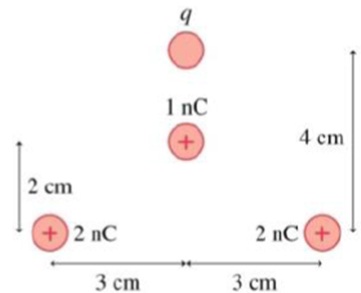Assignment:
1. An atom has 8 protons and 17 nucleons. If it undergoes beta - decay, what are the number of protons and neutrons, respectively, in the daughter nucleus?
A) 8, 17
B) 8, 18
C) 7, 16
D) 9, 17
2. What is the photon energy of blue light has an eneragy of 5.68x10-19 J, what is its wavelength?
A) 450 nm
B) 350 nm
C) 550 nm
D) 200 nm
3. If a long current carrying wire created a magnetic field of 1.2 x 10-7 T, what is the current if you are 12.0 cm from it?
4. The energy of a 2.00 keV electron is known to within ±3.00%. How accurately can its position be measured?
A) 4.0 x 10-10 m
B) 1.5 x 10-10 m
C) 8.4 x 10-10 m
D) 2.1 x 10-10 m
5. If light is traveling from a material with an index of refraction of 1.57 into air, what is the critical angle for total internal reflection?
A) 39.6o
B) 15.9o
C) 97.3o
D) 12.1o
6. An electron is accelerated from rest to a speed of 7.89 x 106 m/s, what potential difference did it cross?
A) 300 V
B) 512 V
C) 295 V
D) 177 V
7. In the ground state, the quantum numbers (n, l, ml, ms) for hydrogen are, respectively,
A) 1, 0, 0, 0.
B) 1, 1, 1, 1.
C) 1, 1, 1, ±1/2.
D) 1, 0, 0, ±1/2.
8. An object is 25 cm from a thin lens with a focal length of 15 cm. Where is the image formed?
A) 10 cm
B) 39 cm
C) 20 cm
D) 37.5 cm
9. An atom has 97 protons and 251 nucleons. If it undergoes alpha decay, what are the number of protons and nucleons, respectively, in the daughter nucleus?
A) 94, 247
B) 95, 247
C) 96, 245
D) 100, 249
10. The work function of a material is 3.5 eV. If the material is the illuminated with monochromatic light (l = 300 nm), what are:
a) the stopping potential
b) the cutoff frequency
11. If 4.0 × 1018 atoms decay with a half-life of 9.2 years, how many are remaining after 15.2 years?
A) 1.3 × 1018
B) 1.7 × 1017
C) 1.1 × 1018
D) 7.6 × 1017
12. If a circuit has a total resistance of 24 and 2.5 x 1023 e charges flow past a terminal point in 2.0 minutes, what is the applied voltage?
A) 8010 V
B) 12.0 V
C) 9.00 V
D) 80.0 V
13. In the nuclear reaction e- + e+ (assume the particles are not moving to begin with), what is the net energy released in keV?
A) 1,000,000 keV
B) 1022 keV
C) 100 keV
D) 511 keV
14. A photon is incident on a metal that has a work function of 6.80 eV. If the longest wavelength of light is emitted, what type of light is this?
A) radio
B) ultraviolet
C) infrared
D) visible
15. A radioactive sample has a half-life of 10.0 min. If the sample decrease by a factor of 1/16 how much time has passed?
A) 15.0 min
B) 10.0 min
C) 20.0 min
D) 40.0 min
16. If an energy intensity of 2000 W is exerted by a spherical source what will be its average power output at a distance of 12 m from it?
A) 3.1 W/m2
B) 1.1 W/m2
C) 2.1 W/m2
D) 4.1 W/m2
17. A circuit has two resistor in series. The first is 1000 Ω and the second is 10,000 Ω . If the applied voltage is 12.0 V what is the power dissipated in each resistor?
18. A radioactive sample has a half-life of 2.5 min. What fraction of the sample is left after 40 min?
A) 1/65536
B) 1/40
C) 1/8
D) 1/256
19. See the figure. If net force on the 1 nC charge is zero. What is q? (n is nano and means 10-9)

A) 12.0 nC
B) 0.68 nC
C) 0.75 nC
D) 1.0 nC
20. In the fission reaction (0n1) + (92u235) → (38sr88) + (54Xe136) + x (0n1)
How many neutrons are produced?
A) 12.
B) 2.
C) 3.
D) 1.
21. A magnetic flux of 50 Wb increases to 100 Wb in 10 seconds, what is the induced emf?
A) 10.0 V
B) 5.0 V
C) No emf is induced
D) 12.0 V
22. Calculate the binding energy of (6C12).
23. The mass of a proton is 1.6726 × 10-27 kg and the mass of a neutron is 1.6749 × 10-27 kg. A proton captures a neutron forming a deuterium nucleus. One would expect the mass of this nucleus to be:
A) equal to (1.6726 + 1.6749) × 10-27 kg.
B) less than (1.6726 + 1.6749) × 10-27 kg.
C) any of these; it depends on the energy released during the capture.
D) greater than (1.6726 + 1.6749) × 10-27 kg.
24. A beam of light traveling in air is incident on a transparent plastic at an angle of incidence of 26o. What is the angle of refraction 35o if the index of refection of the material is 1.41?
A) 18o
B) 51o
C) 12o
D) 26o
25. If the force between two charges decreases by a factor of 100 because the charges are moved further apart?
A) 16
B) 10
C) 8
D) 2